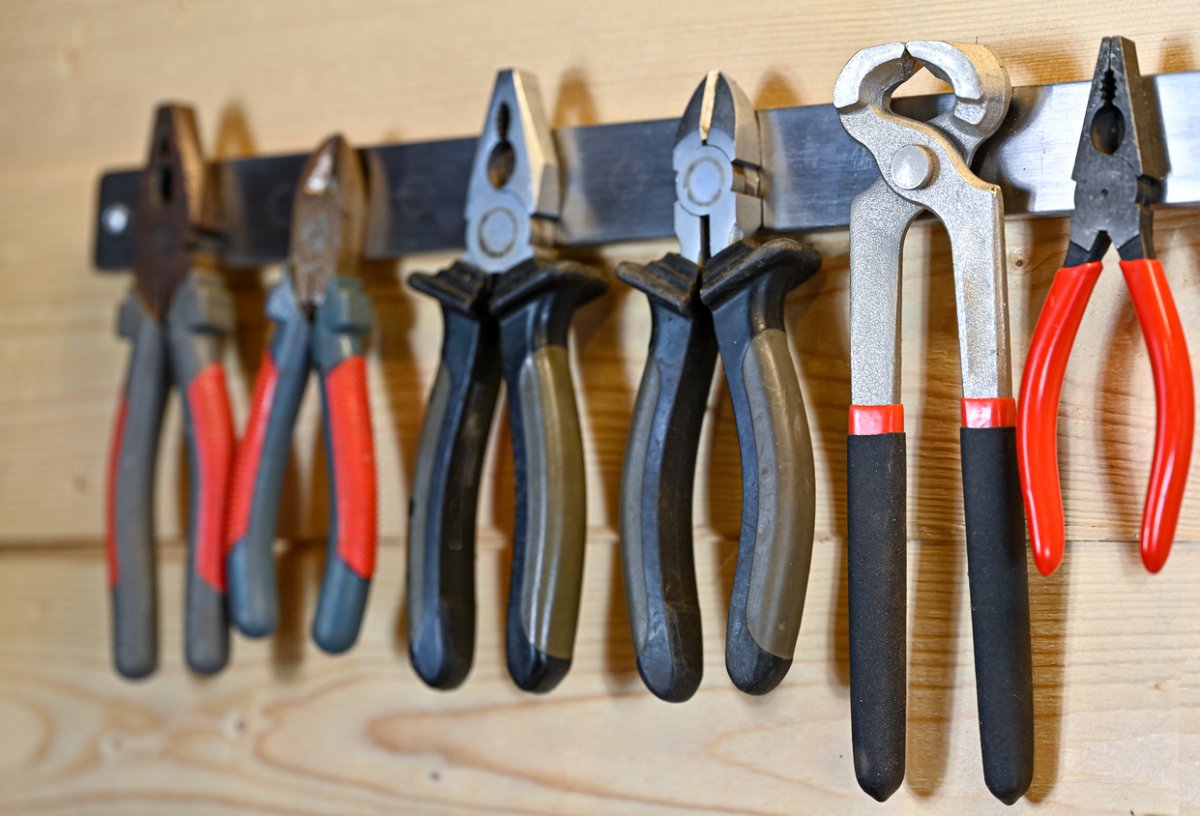We may earn revenue from the products available on this page and participate in affiliate programs. Learn More ›
Pliers are one of those essential tools that most every DIYer and professional has in their tool arsenal. Used to grip, position, tighten, loosen, and cut, pliers help accomplish a variety of jobs around the house and garage, whether it involves fixing a bicycle, creating a craft, repairing the kitchen stool, or accomplishing a bit of wiring. However, not every set of pliers is right for every job, which is why most tool users have a few different kinds in their tool box.
Keep reading to learn about 25 types of pliers, including common types like slip-joint, linesman, locking, and needle-nose and specialty tools like welding pliers, oil filter pliers, and fencing pliers. After learning more about their differences, you’ll be better able to decide which types of pliers are best for your needs.
Parts of Pliers
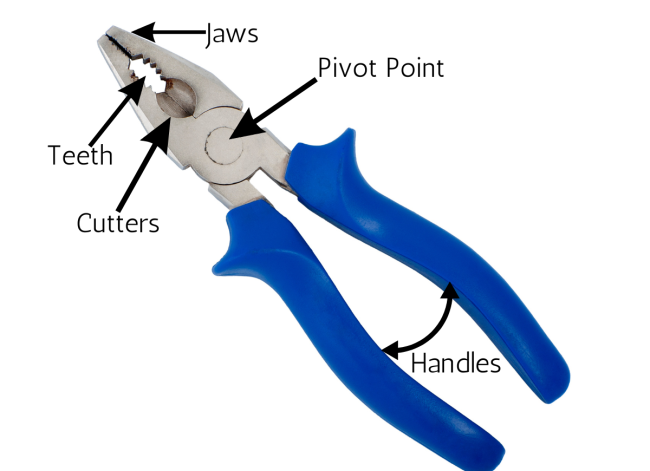
There are several parts of a typical set of pliers that are fairly universal across all most pliers types. Here are the common parts of typical pliers.
- Handles: The handles are the parts of the pliers that the user squeezes. They’re often coated with a nonslip material like rubber or silicone, and they provide the leverage necessary for the jaws to bite down on an object and manipulate it. For added comfort, consider choosing a pair with insulated handles.
- Jaws: Jaws are the part of the pliers that grip the object. They often have serrated or cross-hatched teeth to provide more grip. Some jaws are angled while others might have several different gripping sections with different shapes.
- Pivot point: The pivot point is the hinged area that allows the user to open and close the jaws. As the handles open, the pliers rotate at the pivot point, opening the jaws. Then, as the user closes the pliers, they rotate again at the pivot point, providing leverage on the jaws.
- Teeth: The teeth are the parts of the pliers that contact the object. They’re attached to the inside of the jaws and they can be serrated, angled, or cross-hatched, depending on the pliers’ primary intended use. Keep in mind that the serrated teeth on most locking pliers can permanently damage the parts onto which they are clamped.
- Cutters: Many pliers have sections known as cutters. These are tapered blades between the jaws that pinch together to sheer pieces of wire. Not all types of pliers have cutters, but they are common.
Common Pliers
From locking pliers to needle-nose pliers, there are some types of pliers that DIYers will more find useful than others—and more frequently used. These commonly used pliers often have multiple uses for a variety of projects, and deserve places in your tool kit.
1. Slip-Joint Pliers
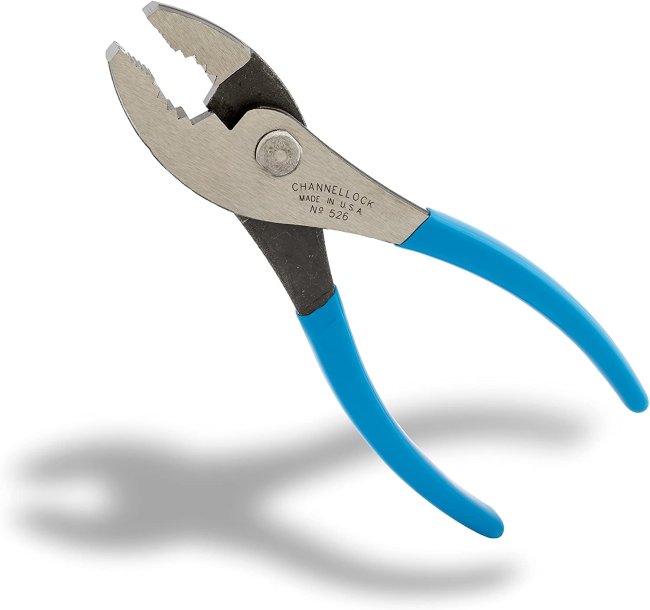
A pair of slip-joint pliers isn’t exactly a high precision tool, but it can be used to securely grip objects ranging in thickness from a single sheet of paper to a half inch or more, depending upon the size of the pliers. The reason this tool is so versatile is the slip joint. Like most pliers, slip-joint pliers are operated by opening and closing the handles, which produces an opening and closing action of the jaws. These pliers have the added advantage of an adjustable pivot point, which allows the two parts of the jaws to be shifted with respect to one another. Most slip-joint pliers have two or three ways in which to position the pivot point.
At the mouth, the pliers’ jaws are flat and serrated, but they curve at the back of the jaw near the pivot. Once known as the burner grip because it was originally used for removing the jets from gas lamps, this curved area will grip rounded objects like pipes or rods. Many slip-joint pliers also have a wire cutter built into the neck of the pliers, just behind the curved serrations.
Slip-joint pliers are available in sizes ranging from a few inches long up to 10 inches, and they are also manufactured in bent-nose and narrow-nose configurations.
Best For: Minor repairs or adjustment tasks around the house
Our Recommendation: Channellock 6-Inch Slip-Joint Pliers at Amazon for $10.95
This pair of high carbon steel 6.5-inch slip-joint pliers has a wire cutting shear for soft wire, serrated jaw, and two-position adjustment.
2. Water-Pump Pliers

Water-pump pliers are not the sole province of plumbers, as they have a variety of other applications. Sold in designs known as arc-joint pliers, Channellock Pliers (a proprietary name), and known in conversation simply as “pumps,” these tools are designed for gripping pipes. The jaws are angled to the length of the handles so that reaching between joists and into awkward spaces is easier, and the handles are long in proportion to length of the tool, providing for maximum leverage.
The jaws of water-pump pliers are serrated, with a curved shape, and they can be adjusted to grasp various sized objects. The pivot point on arc-joint models shifts, while others have a series of grooves that allow the jaws to be positioned at different openings that keep the jaws parallel to one another. The varieties with the channel design offer a more positive grasp of the pipe or other object. Water-pump pliers come in various sizes, ranging from 4 to 16 inches in length, and the models in the middle of that range are the most generally useful.
Best For: Gripping pipes that are between joists and in awkward spaces
Our Recommendation: Knipex Tools Cobra Water Pump Pliers at Amazon for $29.90
These 10-inch water-pump pliers from Knipex offer a built-in pinch guard, self-locking adjustment, and 25 adjustments positions.
3. Linesman’s Pliers
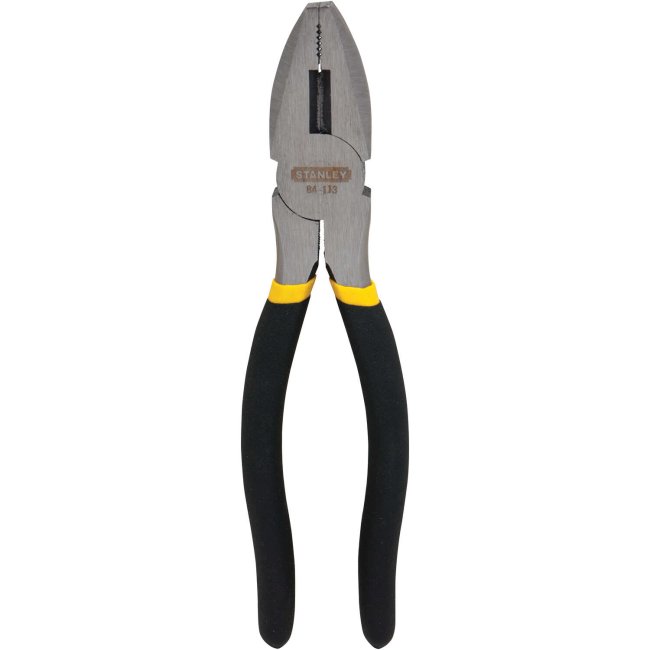
Sometimes called electrician’s pliers or engineer’s pliers (a version without insulated handles), linesman’s pliers are descendants of 19th century tools called bell pliers, because they were used by bell hangers for cutting and twisting the wires used to connect un-electrified household bells.
The jaws have shallow serrations for firm gripping, especially of flat objects like sheet metal, which explains their popularity among sheet-metal workers. An electrician relies upon the jaws for twisting together wires into a cone-shaped knot that is then protected by a plastic insulator called a wire nut. Immediately behind the jaws are a pair of side cutters, designed for cutting wire. Using them to cut nails will dull them quickly.
Though the pliers are sold in various sizes, with lengths from 5 to 10 inches, the 8-inch size serves most needs. Even if they are called electrician’s pliers, never use these–or any other tools–on live wires. Always remove the fuse, turn off the breaker, unplug the cord before performing any electrical work.
Best For: Firm gripping of flat objects like sheet metal
Our Recommendation: Stanley 8-Inch Linesman Plier at Ace Hardware for $9.59
These 8-inch linesman alloy steel pliers offer a double-dipped slip-resistant grip and a chrome-nickel steel cutting edge.
4. Locking Pliers
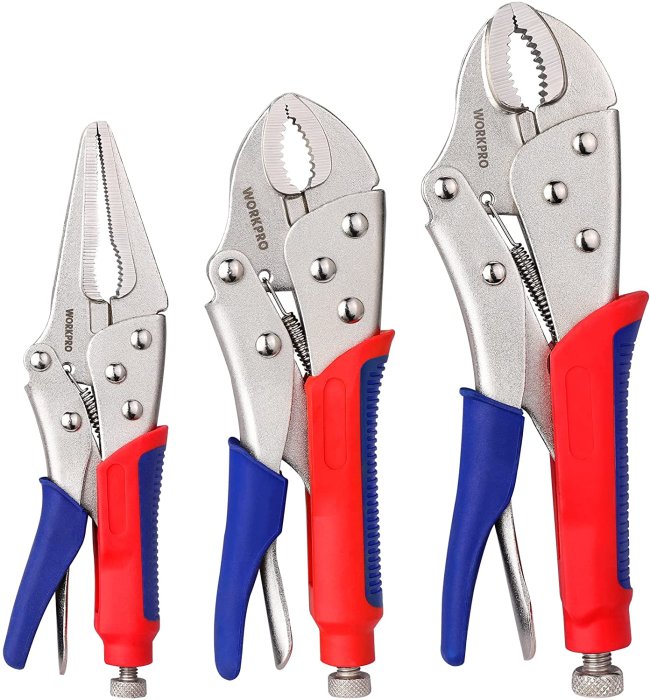
These adjustable pliers are designed to be used as a hand-held vice or clamp that locks firmly onto a workpiece. Also called plier wrenches, lever-wrench pliers, and by the proprietary name Vicegrips, they have a double-lever action.
Their jaw opening is adjusted by turning a screw-drive in one handle and when the jaws contact the object to be gripped, the added pressures lock it in a vice-like grip. To release the tool’s grip, a lever in the other handle is triggered. The compound lever action of the tool means that the jaws can apply tremendous force.
Locking pliers are manufactured in several different configurations and sizes. Most have serrated, straight jaws, and are found in lengths ranging from 4 to 12 inches but curved jaws, long-nose, flat-jaw, smooth-jaw, and C-clamp configurations are also available. The multipurpose locking pliers can be used in place of pipe wrenches, adjustable wrenches, or even clamps.
Best For: As a hand-held vice or clamp in place of pipe wrenches, adjustable wrenches, or even clamps
Our Recommendation: WorkPro Locking Plier Set at Amazon for $18.99
The drop forged and heat-treated steel locking plier set offers both straight and curved jaws with antislip handles.
5. Needle-Nose Pliers
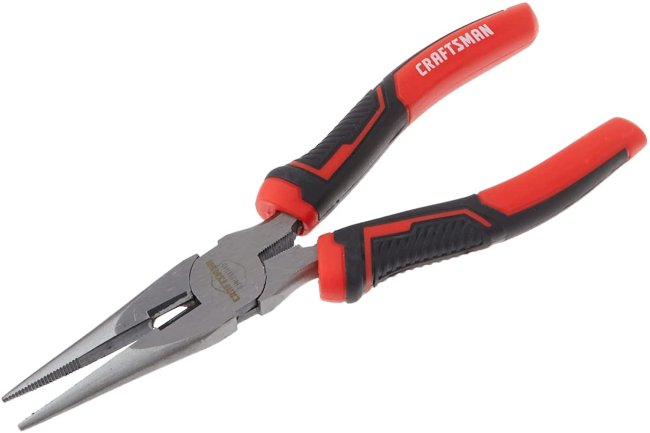
These are essentially small-scale electrician’s pliers, with long, tapered jaws. Smaller in scale than linesman’s pliers, the needle-nose pliers are particularly well suited to working with wire in confined spaces like electrical boxes, though they are also useful for bending and holding metal fittings. Their jaws taper to a point, and at the nose have serrations on the gripping surface. At the throat of the tool near the pivot, there is a side cutter.
Sometimes called radio pliers, this tool is also handy for working with small nuts, washers, or other pieces that need to be precisely placed, perhaps out of the reach of your fingers. Needle-nose pliers also can have their tips bent at angles of 45 or 90 degrees to the line of the handles.
In using needle-nose pliers, keep in mind that they are not for heavy-duty work. They are delicate tools, and their jaws can be sprung, bent, or broken, if abused.
Best For: Delicate work like when working with wire in small spaces like inside electrical boxes or working with small pieces like washers
Our Recommendation: Craftsman Long Nose Pliers at Amazon for $12.98
These 8-inch-long drop forged steel needle-nose pliers have a corrosion-resistant chrome finish.
6. Diagonal Pliers
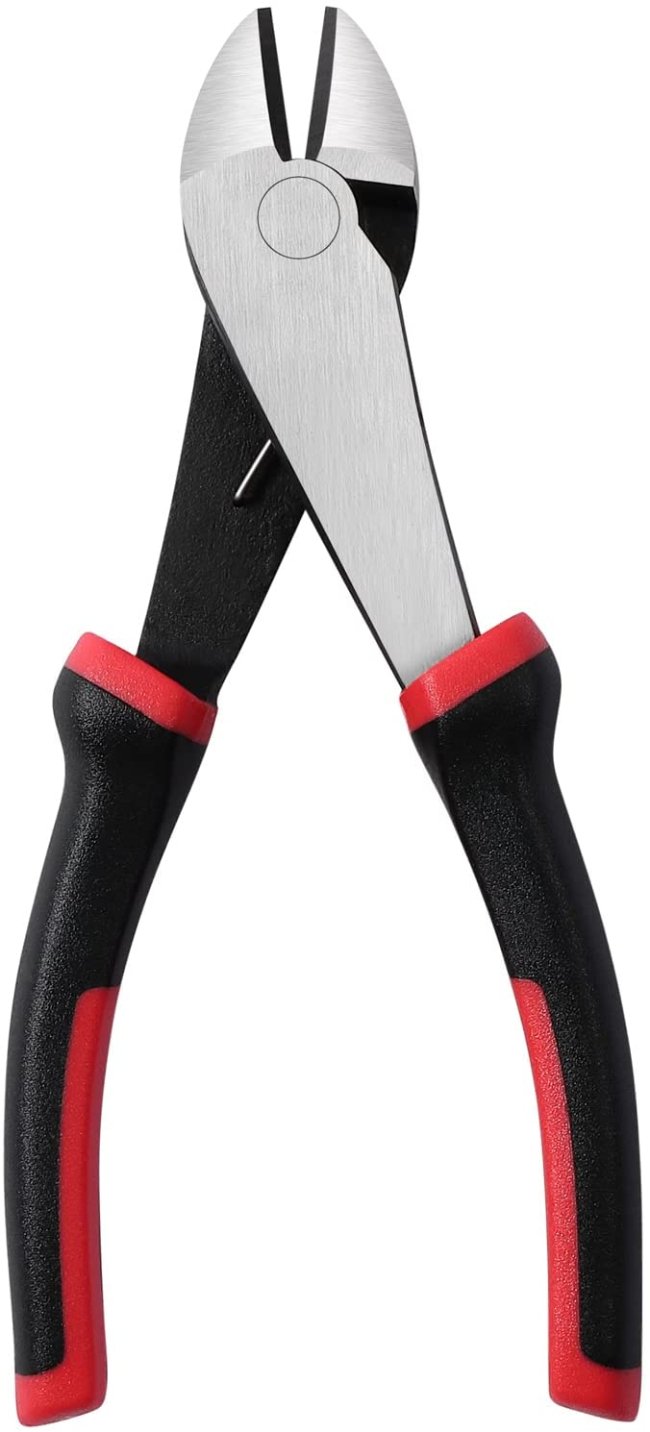
Diagonal pliers, diagonal cutters, or cutting pliers all refer to a type of pliers designed to cut. Generally speaking, these pliers have tapered jaws that come to a point, with a bevel cutting edge between them. While the edge isn’t typically extremely sharp, enough pressure applied will cut through a surprising amount of materials.
Diagonal pliers are useful for cutting a range of items. They can cut electrical wires, steel braided cable, nylon packing straps, wire ties, and so much more. However, because of their beveled edges, they aren’t useful for gripping or twisting anything.
Best For: Cutting wire, cable, straps, and other objects
Our Recommendation: Igan Diagonal Cutting Pliers at Amazon for $11.76
Igan’s diagonal cutting pliers are compact enough to fit in tight spaces, but exert plenty of force for powerful cuts.
7. Raptor Pliers

Raptor pliers are a brand-specific name given to a unique set of pliers by Knipex. These pliers are really a combination of water pump pliers and an adjustable wrench. They have hooked jaws but smooth profiles, and their handles lock and unlock, allowing the user to adjust the jaw size. Those smooth jaws are also hex-shaped, allowing them to grab onto nuts and bolts securely.
Useful for grabbing onto any fasteners with hex-shaped heads, this includes automotive settings, furniture assembly, and basic repairs around the house. They’re a general-purpose tool with a very unique and useful design.
Best For: General purpose repair and assembly with hex-shaped fasteners.
Our Recommendation: Knipex Raptor Pliers at Amazon for $37
The Knipex Raptor Pliers feature hex-shaped jaws, locking adjustments, and ergonomic handles.
8. Bent Nose Pliers

Bent nose pliers are very similar to needle-nose pliers in almost every way except one: Needle-noses have straight jaws while bent nose pliers feature a hooked design. Otherwise, these tools have tapered jaws that come to a point as well as cutting edges designed to slice and strip wires just like standard needle-nose pliers.
Bent nose pliers are incredibly handy in a variety of situations. They can make reaching into tight areas easier than needle-nose versions, as the user’s view isn’t blocked by their hands. They are also helpful when bending wire for electrical connections or picking up small parts with better accuracy than a set of needle-nose pliers.
Best For: Precision situations, reaching into awkward spaces, picking up small parts, bending wires
Our Recommendation: Irwin Tools Vise-Grip Bent Long Nose Pliers at Amazon for $16.99
The Irwin Vise-Grip bent nose pliers feature cushioned grips and a long design meant to work in confined areas.
9. Combination Pliers

Combination pliers are very similar in design to linesman’s pliers, but they’re a little lighter-duty and have slightly different jaws. Combination pliers’ jaws consist of sections for gripping and stripping wires as well as concave sections for gripping nuts, bolts, round pipes, and other items. Combination pliers occasionally have built-in crimpers, as well.
Combination pliers are excellent general-purpose pliers to keep in a tool box. They can perform light-duty electrical work while also helping with general repairs and assembly tasks. Being lighter than linesman’s pliers, they won’t cut through heavy-duty metal or wires as readily.
Best For: Light-duty electrical, repair, and assembly tasks
Our Recommendation: Knipex Combination Pliers at Amazon for $23.14
Knipex’s combination pliers are a bit more durable and capable than other pliers of the type. They have both flat and concave sections, as well as induction-hardened cutting edges.
RELATED: 15 Tools Every First-Time Homeowner Needs
10. Locking Pliers

Locking pliers are a handy tool to have around. They have knobs on the bottom of their handles that adjust the width of the jaws. Once adjusted properly, the jaws will lock into place when the user squeezes the handle. The user then has to pull the handles apart to get the jaws to release.
Locking pliers come in a wide variety of jaw shapes. They’re useful in shop settings such as when holding two pieces of metal together or when finding the correct wrench will take too long. These wrenches can grip the material and lock on, holding the item in place or preventing it from coming apart.
Best For: General purpose repairs, quick fixes
Our Recommendation: Irwin Vise-Grip Original Locking Pliers with Wire Cutter at Amazon for $14.99
These locking pliers from Irwin feature a durable design and apply plenty of force for locking onto a variety of materials.
Specialty Pliers
Many DIYers and professionals need project-specific pliers like nail puller pliers, hose grip pliers, and welding pliers from time to time. It’s also helpful to know about the different kinds of specialty pliers available, because it’s easier to complete a project when you know which tool is best-suited for the task at hand.
11. Crimping Pliers
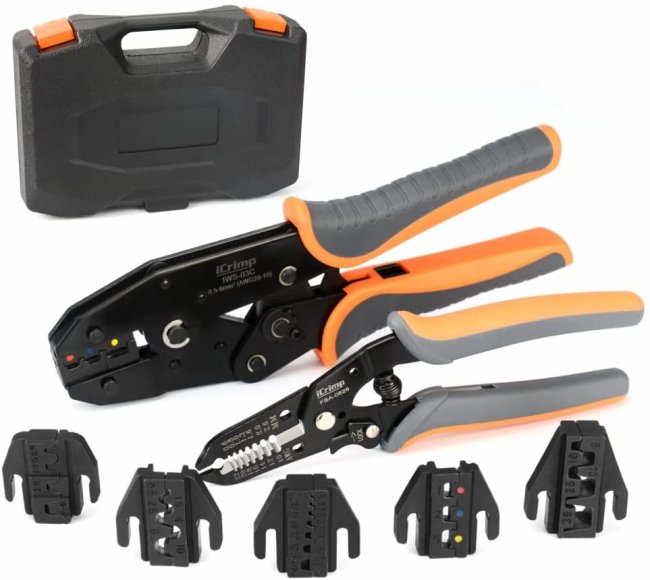
Crimping pliers serve a very specific task. Rather than turning pipes or twisting fasteners, these pliers squeeze electrical terminals onto the ends of wires. They look similar to standard pliers, with two rubber-coated handles and symmetrical jaws of equal length, but their fulcrum is typically a bit further toward the jaw. This provides a bit more leverage for bearing down on terminals.
They can combine wires with a splice or install a variety of wires on the end of a terminal. Most crimping pliers are suitable for several sizes of wires thanks to their varying jaw sizes. Some actually feature swappable jaws, or “dies,” that the user can replace for specific terminal types and shapes.
Best For: Installing electrical terminals and splices on electronic wiring
Our Recommendation: Iwiss Ratcheting Crimper Tool Set at Amazon for $45.29
This crimping plier kit comes with a range of swappable jaws and a ratcheting action that makes applying pressure a breeze.
12. Hose Clamp Pliers
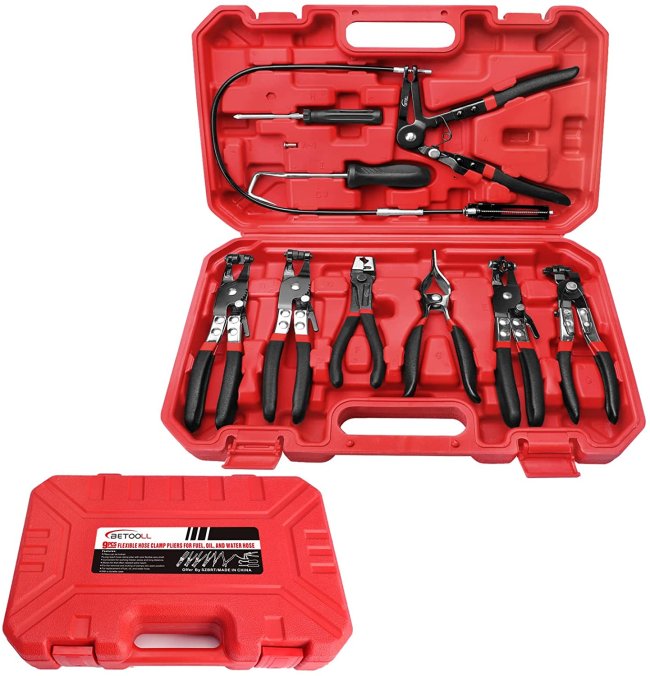
Hose clamp pliers designs allow them to quickly and securely install ring-shaped clamps over hoses and fittings. They have metal jaws that swivel, allowing users to grab these clamps at nearly any angle. Many also have locking levers that will hold the jaws in the exact position required without the clamp springing away.
These pliers are most commonly used in automotive settings, as they’re useful in manipulating the clamps that hold radiator hoses in place. However, they may be used when working on pools, spa plumbing, sump pumps, and other appliances.
Best For: Working on automotive hoses, pools and spas, sump pumps
Our Recommendation: Betooll Hose Clamp Pliers Set at Amazon for $40.94
This hose clamp pliers set from Betooll comes with several pliers as well as a flexible hose clamp plier for reaching into awkward spaces.
RELATED: 13 Essential Tools for DIY Auto Maintenance
13. Snap Ring Pliers
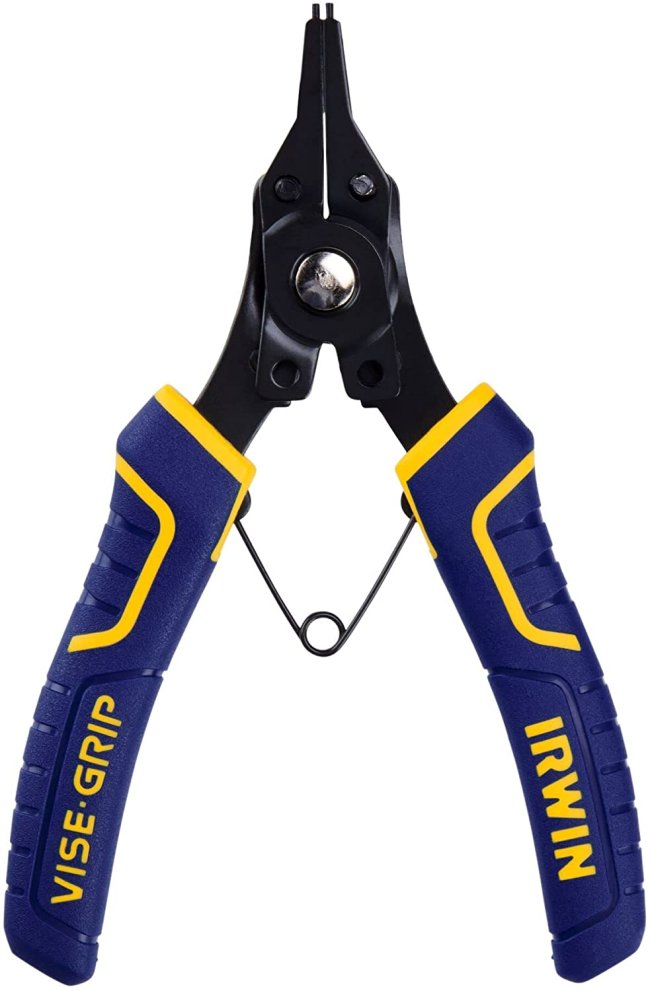
Snap rings are some of the most frustrating fastening devices to install. They’re highly springy, so forcing them on without the utmost control will send a snap ring soaring through the air, never to be seen again. Snap ring pliers, on the other hand, fit into the holes or grooves of a snap ring or retaining clip, which allows the user to manipulate the snap ring without losing it.
Snap ring pliers are handy for a wide range of applications. Retaining clips and snap rings are common on appliances, hose fittings, valve repairs, and other projects. They have pointed jaws with small pegs on the end that fit into the snap ring’s holes, so the user can compress the ring or expand it, depending on the scenario.
Best For: Appliance repair, valve repair, and automotive settings
Our Recommendation: Irwin Vise-Grip Convertible Snap Ring Pliers at Amazon for $12.99
With comfortable grips and swappable jaws, this tool can handle any snap ring.
14. Bail-Making Pliers
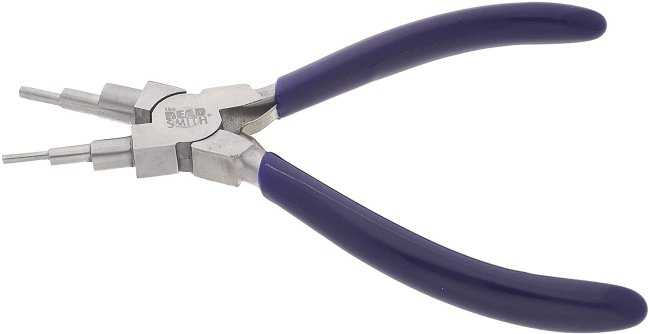
Bail-making pliers are a common jewelry making tool. Outside of jewelry and crafts, there aren’t many uses for bail-making pliers.
These pliers have cylindrical jaws, and the cylinders that make up the jaws vary in size so users can bend wire around the barrel sections, creating coiled wires for decorative purposes. Each barrel size represents a different size coil, allowing the user to choose the size that best fits the design.
Best For: Jewelry and crafts
Our Recommendation: The Beadsmith Wire-Bending Pliers at Amazon for $12.65
The Beadsmith wire-bending pliers features six sizes, allowing crafters to create a wide variety of bends and coils.
15. Battery Pliers
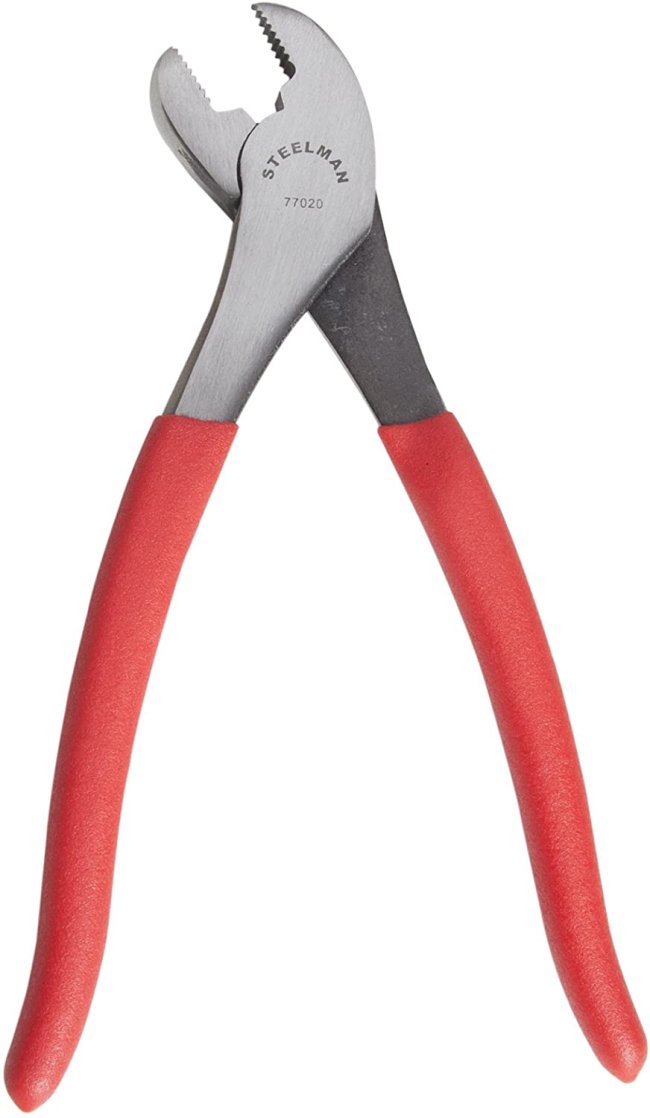
Battery terminals on cars, motorcycles, lawn equipment, and other applications often use hardware with square-shaped heads. While a standard pair of pliers can usually handle these bolts, a set of battery pliers has square-shaped jaws that provide plenty of surface area for gripping them without stripping or rounding them over.
These pliers look pretty standard at first, but closer investigation shows serrated teeth within the jaws, allowing these pliers to bite down on the terminal for plenty of grip. They don’t adjust, either, as most battery terminal bolts are essentially universal in size. The heads are slightly angled so they are a bit more maneuverable at awkward angles.
Best For: Tightening and loosening battery terminals on vehicles, lawn equipment, motorcycles, and ATVs
Our Recommendation: Steelman 77020 Battery Terminal Pliers at Amazon for $11.99
The Steelman battery terminal pliers feature a nonslip grip, an angled head, and a rounded nose for reaching into tight areas.
16. Fencing Pliers
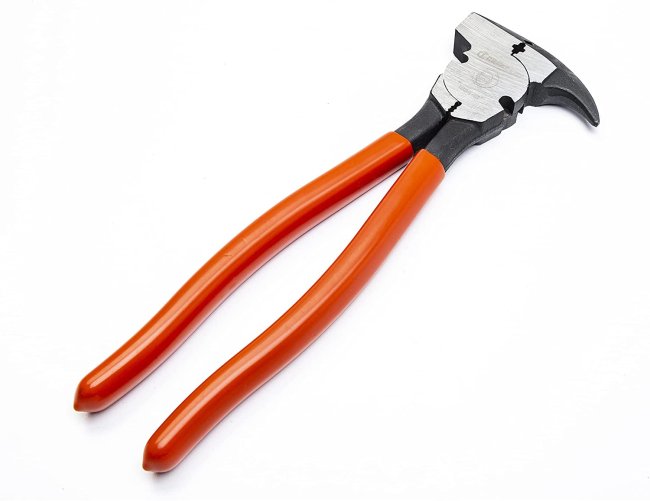
Fencing pliers are funky looking, but they have so many features and functions that the shape actually makes sense.
The flat side of the pliers looks like a hammer, and it’s used to drive staples into wooden fencing. The hooked side that’s opposite the hammer is for pulling staples. The jaws are also able to pull staples, but they’re also used for twisting metal wire tightly, such as when working with agricultural fencing. They even have slots on either side of the pivot that allows the user to cut wire ties to length.
These pliers’ primary job is installing fencing, but they can be helpful when pulling nails and fasteners from wood or cutting wire to length.
Best For: Installing fencing or twisting wire ties
Our Recommendation: Crescent 10-inch Fence Pliers at Amazon for $27.21
Crescent’s 10-inch fence pliers are designed for heavy-duty wire cutting and fencing installation, with electronically hardened cutting edges.
17. Flat Nose Pliers
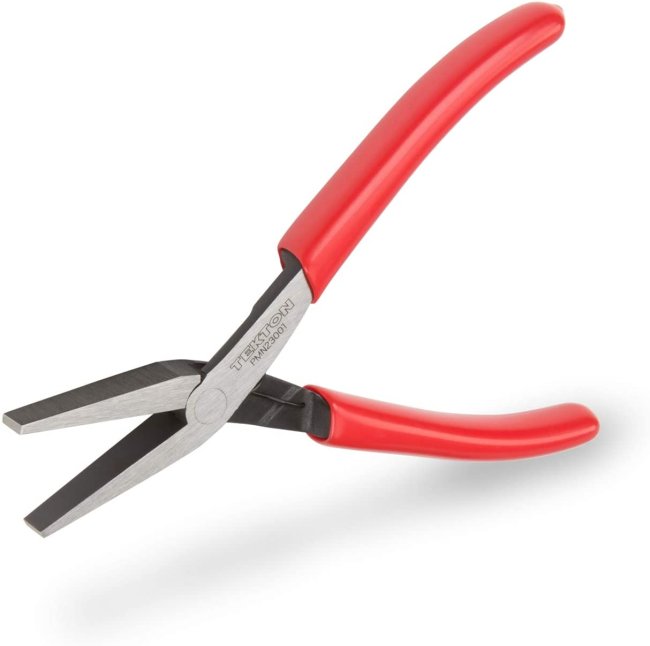
Flat nose pliers are another type of plier used in jewelrymaking. These pliers look similar to needle-nose pliers except that the very tip of the pliers features a stubby, flat end rather than a point. This makes the tip very durable and allows these pliers to perform their primary function: bending metal and wire to shape for crafts.
While their primary use is in jewelry making, flat nose pliers can be helpful when gripping retaining clips and snap rings, providing more surface area than a pair of needle-nose pliers while still allowing the user to reach into tight areas.
Best For: Bending metal and wire, reaching into tight places for small items
Our Recommendation: Tekton Mini Flat Nose Pliers at Amazon for $16
The Tekton mini flat-nose pliers feature smooth jaws for bending metal and wires without marring them.
18. Hose Grip Pliers
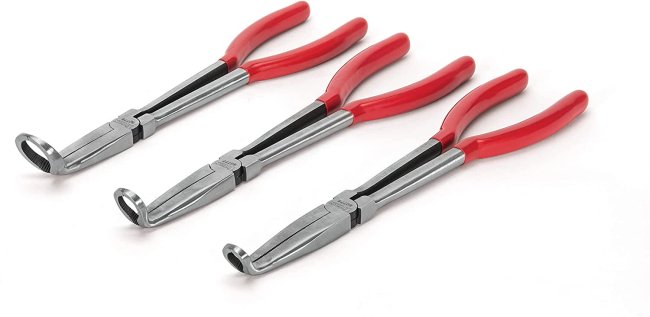
Hose grip pliers are unique-looking tools. They’re long and thin, and feature needle-nose-like shapes, except that the tip of their jaws become a round, loop-like shape. These loops fit over top of hoses and allow the user to push hoses onto fittings or remove them with less effort. The user simply grips the hose and twists it back and forth until it slides on or pulls off.
Generally, hose grip pliers are used in automotive settings where they can be used to install or remove fuel lines, hoses, vacuum lines, and similar parts. They’re also helpful when working on small engines and lawn equipment, as they can reach hoses in tight spaces for easy replacement and maintenance.
Best For: Automotive, small engine, and lawn equipment repairs
Our Recommendation: Titan 3-Piece Hose Grip Pliers Set at Amazon for $29.54
This set from Titan comes with three sets of pliers to install or remove a variety of hoses.
19. Ironworker Pliers
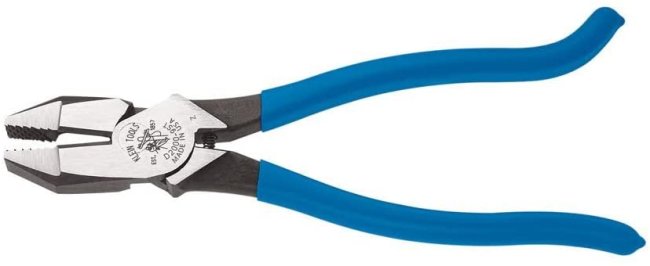
Ironworker pliers look very similar to linesman’s pliers at first glance, but a closer look will reveal their differences. First, ironworker pliers are longer, and their jaws are much heavier duty and wider. Also, those longer handles feature one hooked handle.
Ironworker pliers are meant for twisting and cutting heavy-duty rebar wire, which is why they’re so much burlier than linesman’s pliers (which usually cut soft copper wire). The handle design also provides more leverage when cutting through these hardened wires. Some models have tempered handles that absorb some of the shock felt when cutting these materials, as well.
Best For: Cutting and twisting metal wire ties for rebar or any heavy-duty cutting scenario
Our Recommendation: Klein Tools Ironworker Pliers at Amazon for $52.99
The Klein Tools ironworker pliers feature a high-leverage design that improves cutting force up to 46 percent, according to Klein.
20. Wire-Twisting Pliers
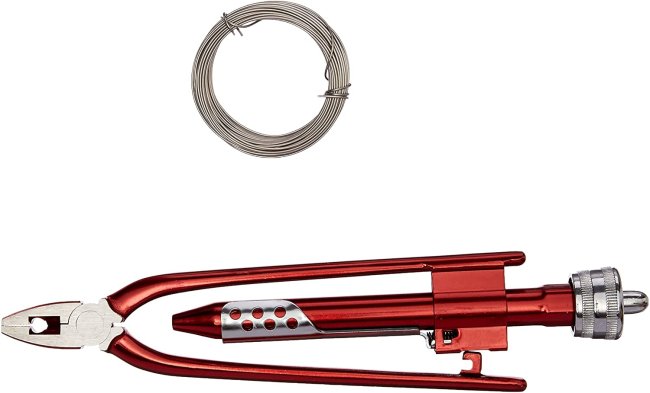
Even with a pair of pliers, wire-twisting can be a headache. But, wire-twisting pliers designed specifically for this task make it much easier. These pliers typically look like linesman’s pliers with a cylinder between the handles. They have standard jaws with serrated, flat sections, as well as cutting edges, and are helpful when installing rebar before a concrete pour, or when installing fences.
When the user needs to tie wire, they simply cut the wire to length, wrap the objects that need tying, place both ends in the jaws and lock the jaws, and then pull back on the knob at the end of the cylinder. This will automatically twist the wire cleanly and uniformly.
Best For: Tying rebar or installing fences
Our Recommendation: BikeMaster Safety Wire Pliers with Wire at Amazon for $35.85
The BikeMaster safety wire pliers are forged steel and feature a spring-loaded return for easy twisting.
21. Nail Puller Pliers

Nail puller pliers are a bit strange looking, but they can be an unbelievable help for renovation and restoration projects. They have standard-looking jaws with serrated teeth to grip nail shanks, as well as a wide, curved pivot point that rides on the material to make applying leverage easier. Other models may have cutting-style jaws that pinch the shank but serve the same purpose.
Why would someone need nail-pulling pliers when a hammer might do the job? The best way to remove a nail from a piece of molding or wood that will be reused is to pull through the wood, not back out of it. Hammer claws struggle to grip nail shanks, but nail puller pliers can grip them easily and make pulling them through the wood a cinch.
Best For: Removing nails from reusable wood in renovation or restoration projects
Our Recommendation: Crescent 11-Inch Nail Puller Pliers at Amazon for $25.99
The Crescent nail puller pliers feature a large pivot point for minimizing marring and maximizing leverage.
22. Oil Filter Pliers

Oil filters get slippery. Whether it’s a car, tractor, lawn mower, or another vehicle, anyone who has ever tried to remove a slick, greasy oil filter knows how much of a headache it can be. Rather than struggling and potentially getting injured, DIY mechanics use a set of oil filter pliers to make the job easier.
Oil filter pliers have long, curved jaws with three or four sets of teeth. These teeth grip the filter and make applying leverage very easy. Most of these pliers are also adjustable, allowing them to fit small filters or large filters on heavy machines, reducing the need for multiple pairs.
Best For: Automotive, lawn equipment, and heavy equipment maintenance
Our Recommendation: Channellock 209 9-Inch Oil Filter Pliers at Amazon for $19.95
The Channellock Oil Filter Pliers are adjustable, allowing them to fit multiple filter sizes, and their 9-inch length makes applying leverage easier.
RELATED: 13 Hacks Every Car Owner Should Know
23. Running Pliers
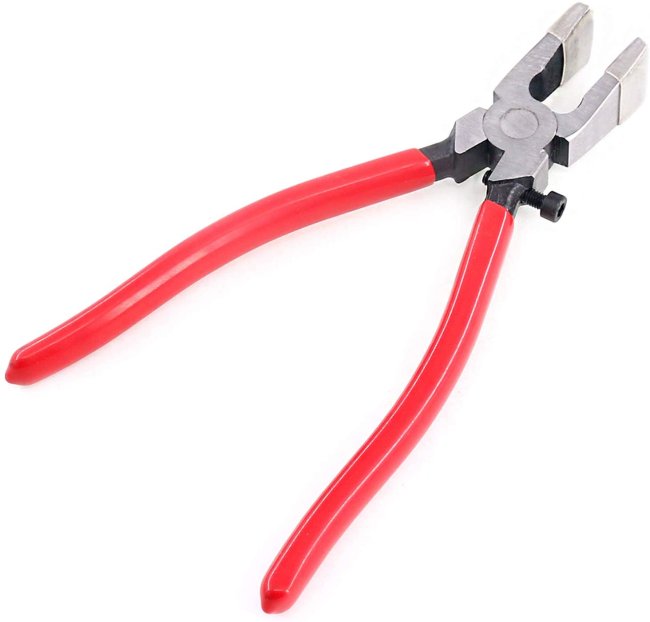
Running pliers are used in glass work, such as when cutting glass to shape for window or picture frames. These pliers appear similar in size and shape to linesman’s pliers, but their jaw surfaces are curved. After scoring the glass, the pliers are placed in line with the score and squeezed, bending the glass at the score mark until it snaps.
For the average DIYer, running pliers are likely the only glassworking pliers necessary, as they can break thick glass relatively easily. However, their capabilities do fall short on longer cuts and score lines as well as breaking scored circles from glass. Also, note that running pliers are available in plastic and metal versions, with the metal options being far more durable.
Best For: Snapping glass panes for picture frames and smaller window repairs
Our Recommendation: Swpeet Running Pliers at Amazon for $10.84
The Swpeet heavy-duty running pliers feature a durable metal design, an adjustable stop, and coated jaws to prevent marring.
24. Soft Jaw Pliers

Exposed plumbing pipes above or below a sink or toilet in a fashionable setting show the handiwork of soft jaw pliers. Soft jaw pliers are essentially water pump pliers with rubber, plastic, or silicone gripping pads. Their purpose is to grip around objects like pipes and twist them into place without marring them.
In most cases, the rubber pads on soft jaw pliers are removable, allowing users to replace them when needed or simply use their water pump pliers as standard pliers. This makes them useful for not just exposed plumbing but also general-purpose repairs and standard plumbing.
Best For: Fashionable plumbing installations with exposed pipe, general purpose repairs with the pads removed
Our Recommendation: Knipex Pipe Gripping Pliers with Plastic Jaws at Amazon for $58.32
Knipex soft jaw pliers feature an ergonomic design and a push-button release for size adjustments.
25. Welding Pliers

Welding pliers have some fairly specific uses that the average DIYer who doesn’t weld won’t need. However, for the average DIY welder, they’re very useful. These pliers look somewhat like a combination of a linesman’s pliers and needle-nose pliers, with multiple functions and features built in.
Welding pliers have noses that can grip MIG welding wire or clean slag and spatter. They also have hammer surfaces meant for knocking welding scale loose. They can also cut wire, and they usually have two sets of circular jaws for gripping welding gun nozzles and fittings. All of these features make welding much easier, because it reduces the number of tools needed from six tools to just this one.
Best For: Welding purposes like removing spatter and slag or cutting welding wire
Our Recommendation: Irwin Vise-Grip MIG Pliers at Amazon for $18.28
The Irwin Vise-Grip Mig Pliers offer all of the standard welding pliers features as well as being spring-loaded for easy one-handed operation.
Final Thoughts
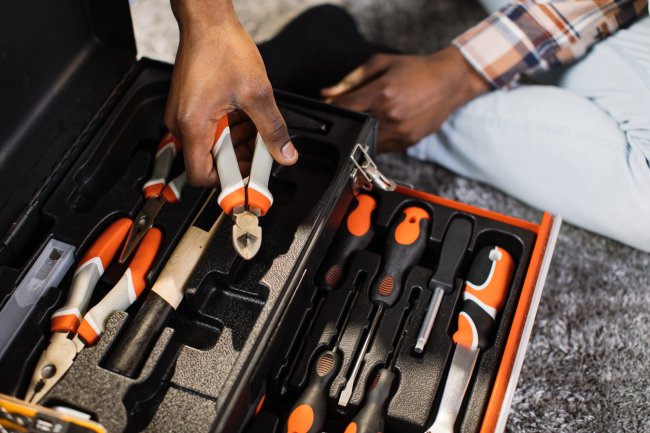
While most DIYers won’t need all of the different types of pliers on this list, they are all important options to consider. From humble slip-joint pliers to locking pliers and adjustable soft jaws, there are pliers out there for almost every project. If you’re looking for more information on choosing the best pliers for your needs, as well as some models we feel are among the best in their respective categories, check out our guide on the best pliers.
Prices listed here are accurate as of March 20, 2023.

